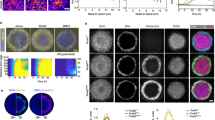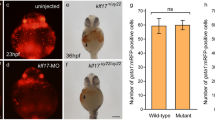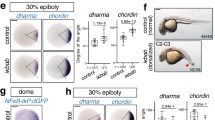Abstract
Arising from: A. V. Gore et al. Nature 438, 1030–1035 (2005)10.1038/nature04184; Gore et al. reply
In fish and amphibians, the dorsal axis is specified by the asymmetric localization of maternally provided components of the Wnt signalling pathway1,2. Gore et al.3 suggest that the Nodal signal Squint (Sqt) is required as a maternally provided dorsal determinant in zebrafish. Here we test their proposal and show that the maternal activities of sqt and the related Nodal gene cyclops (cyc) are not required for dorsoventral patterning.
This is a preview of subscription content, access via your institution
Access options
Subscribe to this journal
Receive 51 print issues and online access
$199.00 per year
only $3.90 per issue
Buy this article
- Purchase on Springer Link
- Instant access to full article PDF
Prices may be subject to local taxes which are calculated during checkout


Similar content being viewed by others
References
Schier, A. F. & Talbot, W. S. Molecular genetics of axis formation in zebrafish. Annu. Rev. Genet. 39, 561–613 (2005)
Heasman, J. Patterning the early Xenopus embryo. Development 133, 1205–1217 (2006)
Gore, A. V. et al. The zebrafish dorsal axis is apparent at the four-cell stage. Nature 438, 1030–1035 (2005)
Schier, A. F. Nodal signaling in vertebrate development. Annu. Rev. Cell Dev. Biol. 19, 589–621 (2003)
Feldman, B. et al. Zebrafish organizer development and germ-layer formation require nodal-related signals. Nature 395, 181–185 (1998)
Gore, A. V. & Sampath, K. Localization of transcripts of the zebrafish morphogen Squint is dependent on egg activation and the microtubule cytoskeleton. Mech. Dev. 112, 153–156 (2002)
Aoki, T. O. et al. Regulation of nodal signalling and mesendoderm formation by TARAM-A, a TGFbeta-related type I receptor. Dev. Biol. 241, 273–288 (2002)
Pei, W., Williams, P. H., Clark, M. D., Stemple, D. L. & Feldman, B. Environmental and genetic modifiers of squint penetrance during zebrafish embryogenesis. Dev. Biol. 308, 368–378 (2007)
Ciruna, B. et al. Production of maternal-zygotic mutant zebrafish by germ-line replacement. Proc. Natl Acad. Sci. USA 99, 14919–14924 (2002)
Gritsman, K. et al. The EGF-CFC protein one-eyed pinhead is essential for nodal signaling. Cell 97, 121–132 (1999)
Sirotkin, H. I., Dougan, S. T., Schier, A. F. & Talbot, W. S. bozozok and squint act in parallel to specify dorsal mesoderm and anterior neuroectoderm in zebrafish. Development 127, 2583–2592 (2000)
Sampath, K. et al. Induction of the zebrafish ventral brain and floorplate requires cyclops/nodal signalling. Nature 395, 185–189 (1998)
Author information
Authors and Affiliations
Rights and permissions
About this article
Cite this article
Bennett, J., Stickney, H., Choi, WY. et al. Maternal nodal and zebrafish embryogenesis. Nature 450, E1–E2 (2007). https://doi.org/10.1038/nature06314
Received:
Accepted:
Issue Date:
DOI: https://doi.org/10.1038/nature06314
This article is cited by
-
Transcriptomic analysis of dead end knockout testis reveals germ cell and gonadal somatic factors in Atlantic salmon
BMC Genomics (2020)
-
Nodal promotes growth and invasion in human gliomas
Oncogene (2010)
-
Gore et al. reply
Nature (2007)
Comments
By submitting a comment you agree to abide by our Terms and Community Guidelines. If you find something abusive or that does not comply with our terms or guidelines please flag it as inappropriate.



